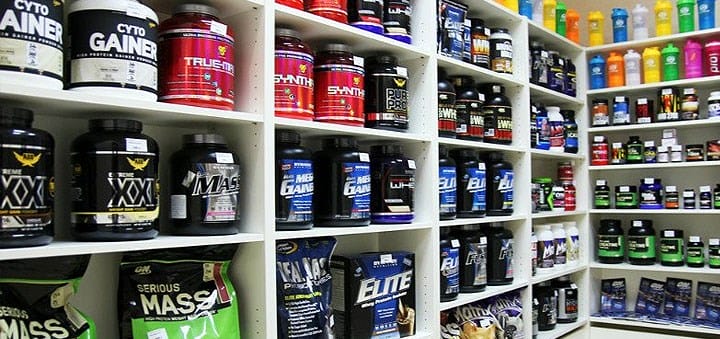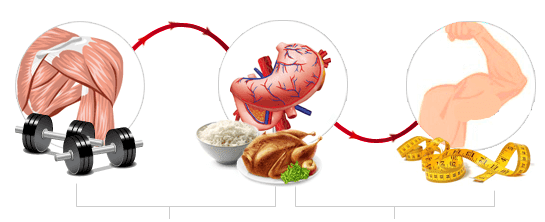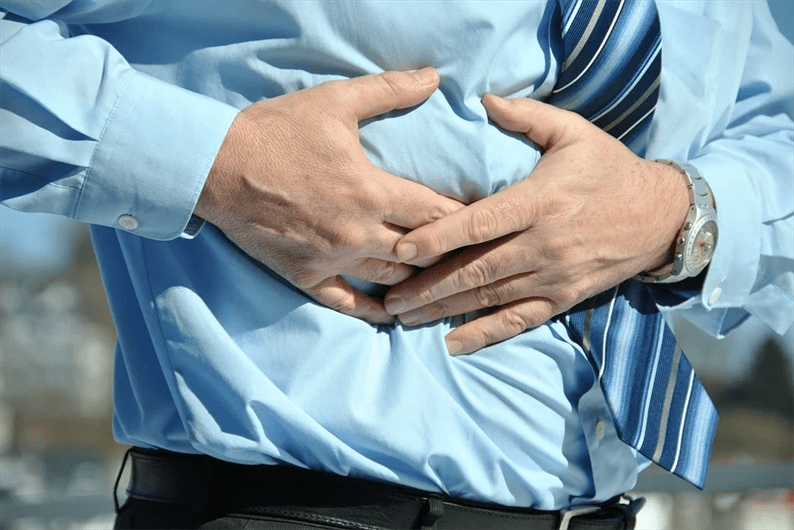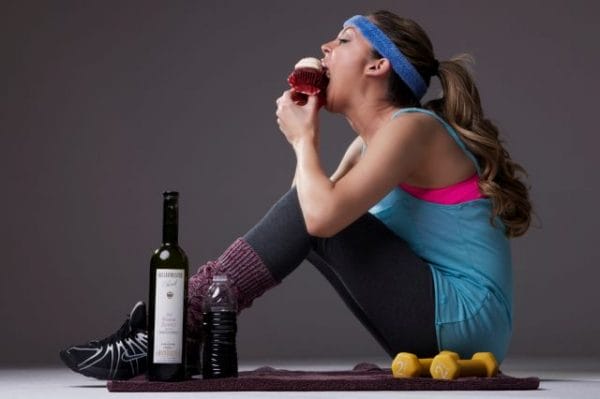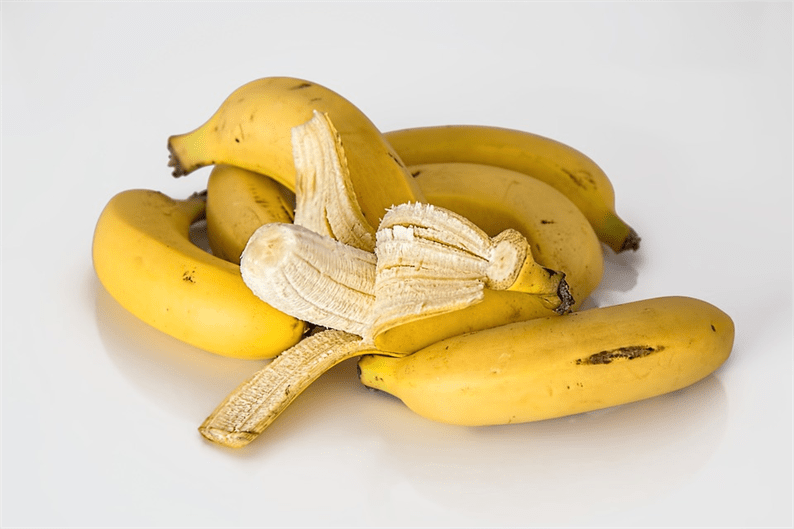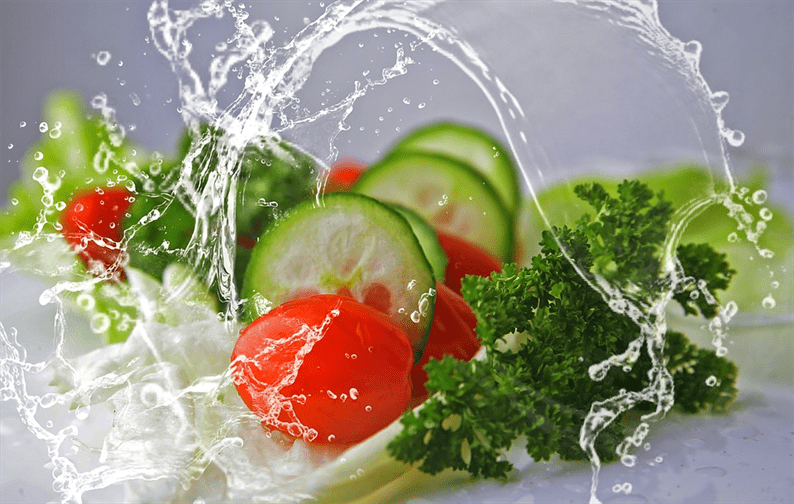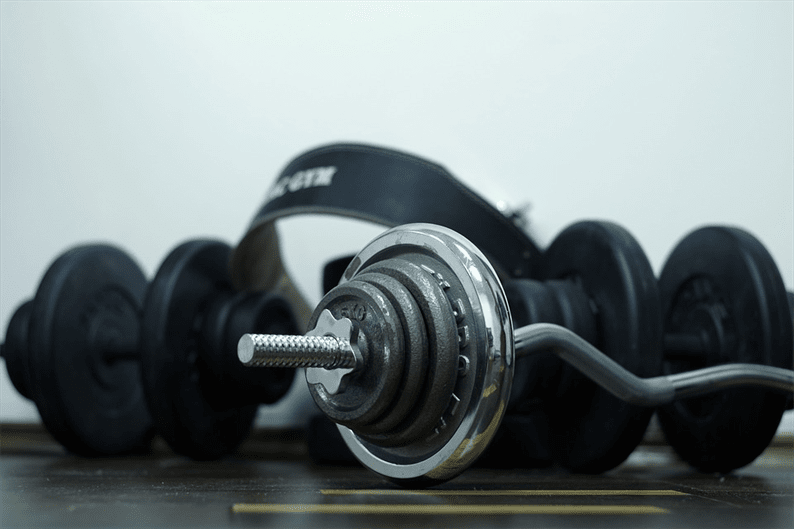Nutritional features depending on the type of training
First of all, it should be noted that there are two main types of training:
- aerobic;
- power.
For example, protein nutrition is suitable for muscle growth, and if you train for the purpose of losing weight, it is better to do with foods high in fiber.
It is also important to get the right time to train. Ideally, it is best to practice in the morning before breakfast. It is also useful for losing weight, because the body will take energy from fat reserves.
When strength training is planned, it is best to eat a heavy meal a few hours before your workout. The dish should be hearty and high in calories. It is advisable to use products containing slow carbohydrates for this. If it is not possible to eat a dense meal a few hours before strength training, you can drink tea with dry cookies or eat a banana an hour before exercising.
On a note! Since there are conflicting opinions regarding the use of banana before and after training, it is advisable to discuss this issue with a trainer.
The main rule that should be adhered to when performing physical activities for weight loss: calorie consumption should exceed their amount consumed with food. It is also important to maintain a drinking regime. Drink water 20 minutes before starting your workout.
Physical activity – recommendations for health
Revitalizing yoga training is aimed at improving physical fitness, preventing civilization diseases, including overweight and obesity.
Current guidelines for healthy adults (ages 18–64) should include endurance exercise (vigorous running, swimming, aquatic exercise, cycling, Nordic walking, dancing) and muscle strengthening (gym exercise).
Endurance exercise has a positive effect on the cardiovascular system, helping to lower heart rate and lower blood pressure. It has a beneficial effect on the lipid profile, improves insulin sensitivity and carbohydrate tolerance.
Long-term, moderate-intensity endurance exercise allows for greater energy expenditure by extending the duration of one-on-one training. Therefore, for overweight people, the best option is a 40 minute intense walk, rather than a crazy 5 minute run, as it will burn more stored fat.
Regardless of what kind of exercises you perform, for endurance, for strengthening muscles, or a set of yogic exercises, their systematicity will be the best option.
The ideal you should strive for when planning your endurance training:
- Moderate intensity workout – 30 minutes, 5 days a week.
- High intensity classes – 20 minutes, 3 days a week.
Diet
For those involved in sports, diet is as important as the quality of food. And you need to know when to exercise after eating. The answer will depend on the size of your portions. For example, if you eat a heavy meal three times a day, then let the break between eating and exercising is at least two hours.
This will be enough for the body to have time to assimilate the eaten. Those who use fractional meals and eat small portions can reduce the time between meals and activity to one hour.
Please note that this is not a universal recommendation, as the time of day during which you exercise is also important. If you train in the morning, then you can start the lesson already 40 minutes after eating. This is due to the fact that in the first half of the day the body is very efficient, and it absorbs food quickly enough. But keep in mind that it must be light and quickly digestible, otherwise it may not be able to cope during this period.
If you have time limits, you can drink a glass of tea or juice instead of breakfast, and start exercising after half an hour. If classes will take place in the afternoon, then after eating, try to wait at least 1.5 hours.
Note that other factors also play a role. For example, the individual characteristics of your body, type of physical activity, duration and intensity of training. For example, an athlete who does active strength training on a regular basis should eat differently than a girl who exercises easily a couple of times a week to maintain a figure.
Another question that interests many people is how much you can eat before training, the purpose of which is to lose weight. Here it is worth remembering the basic principle that allows you to lose weight – you need to spend more energy than you consume. But it is also important not to starve. The diet should be complete and balanced enough to ensure the performance of all systems in your body. If the calorie deficit is too severe, your metabolism will slow down dramatically, and you will get the opposite effect, and you will also earn a lot of health problems.
When to exercise – before meals or after? It all depends on your biorhythms. But in both the first and second cases, a certain time must pass between physical activity and food.
What is the effect on the body of a particular food taken before exercise?
- proteins (proteins). They have anabolic activity – they affect the growth of muscle tissue, the main building material for the cell.
- fats (lipids). Lipid food takes a long time to digest. In addition, fats can significantly slow down the absorption of nutrients. As a result, a person who ate lipid food before training may experience discomfort, which manifests itself in the form of lethargy, nausea, belching and stomach cramps;
- carbohydrates. These foods are essential for proper muscle function. Indeed, in the process of playing sports, the body pretty quickly spends stores of glycogen (glucose). Therefore, they need to be replenished before starting a workout.
Supplements and Sports Nutrition
In addition to healthy nutrition, there are various dietary supplements (biologically active additives) that athletes use to achieve high sports performance. These include:
- Complexes of amino acids “BCAA”, which include valine, isoleucine and leucine. They contribute to the rapid increase in muscle mass;
- Vitamin and mineral complexes in the form of tablets or powders containing fatty acids of the “Omega” group;
- Proteins – natural protein in the form of a powder, which can be of three types according to the rate of absorption: slow, fast and medium;
- Weight gainers, which are made up of carbohydrates. They increase the energy value of meals and contribute to a rapid increase in body weight;
- Fat burners – linoleic acid, carnitine and various complexes that act on a hormonal level, stimulating intense fat burning. Such sports nutrition is used mainly to “dry” a pumped-up body.
Since supplements do not contain synthetic substances, they can be beneficial for athletes. They will come to the rescue if you miss a meal or two, and will also help you recover from intense workouts. However, dietary supplements should not replace a normal meal and should only be taken in consultation with a trainer.
The nuances of a sports diet
The main source of energy before a workout is:
- carbohydrates;
- proteins;
- vegetable fats.
Carbohydrates to maintain blood sugar levels must be complex and low on the glycemic index. Fragrant rolls, pastries and cakes should not be in the diet. They will be replaced for inspiration and energy by vegetables and fruits, berries and smoothies, oatmeal and brown rice, nuts and whole grain breads.
Healthy and tasty. Soaking peeled rice overnight and then steaming it for 10 minutes makes a great pre-workout breakfast. If you soak green buckwheat, then in the morning you can eat it raw or steam it for 5-10 minutes in a double boiler.
Complex carbohydrates are found in durum pasta and cereals. They should be included in the menu in the first half of the day so that the body can break them down by the end of the day.
Protein is essential for preventing muscle breakdown and recovery, as well as weight loss. Protein should be combined with carbohydrates.
To replenish the body with proteins – sources of amino acids involved in the construction of muscle fibers, you can eat:
- lean meat and poultry (without skin);
- seafood (lean fish, oysters, squid, mussels and shrimp);
- low-fat dairy products: yogurt, cottage cheese, cheese.
Alternatively, in the morning you can have breakfast with cottage cheese with berries or a banana, an omelet of two eggs with vegetables, poultry (150 g) with grain bread (100 g), low-fat fish with vegetable salad.
Fats contain fatty acids. They are necessary to normalize metabolic processes. Therefore, you need to add any vegetable oil to salads, but no more than 2 tablespoons. in a day.
Fully or partially limited products
A balanced diet involves the use of any food, but some of them should be limited. These include:
- Sugar, as well as dishes with its content – buns, cakes, pastries. Athletic girls and men who regularly work out in the gym can afford to eat sweets once a week. Losing weight such a luxury is contraindicated;
- Animal fats – pork, lard, fatty lamb. It is better to restrict them completely, as they raise the level of “bad” cholesterol. They cause the greatest harm to the body after heat treatment;
- Sausages and semi-finished products, as well as dumplings, dumplings and other dough products. They contain a lot of meat waste and salt;
- White bread and flour do not contain fiber, have a high glycemic index, which is comparable to sugar;
If you are just starting the path of healthy eating and sports, then limit yourself gradually. But do not eat junk food often, replacing it with healthy, healthy meals.
Exercise physiology
Nutrition, adapted to the human body, its needs, is an important factor affecting its physical form, muscle strength, and the rate of recovery after physical activity.
A properly balanced diet that is acceptable for physical activity can significantly affect the rate of fat burning and the development of muscle tissue, increase the physical capabilities of the body, thereby increasing the duration of training.
Why you can’t exercise right after a meal
You can not play sports after eating, since discomfort and heaviness in the stomach will interfere with exercise.
Digestive problems
You can not run after eating, because undigested food, being in the stomach, begins to move along it. If the breakfast is not hearty, for example, kefir with pieces of fruit, and the stomach does not bother, then you can engage in some kind of physical activity.
In addition to discomfort, there are other reasons why you should not go in for sports right away. Increased activity inhibits the digestive process, since blood will begin to drain from the stomach and flow to the muscles. During movement, nausea and heartburn may begin. These symptoms can spoil the athletic mood.
A condition that does not involve training
During meals, the hormone serotonin is produced. It makes the body sluggish and sleepy, so physical activity after eating is not recommended. It is difficult to concentrate on exercise when the body is relaxed.
Reducing the amount of fat burned
During the digestion of food, insulin is produced. Unused nutrients due to this hormone are deposited in the cells of the body. Exercising after meals is harmful in that some of the substances will go to the formation of adipose tissue. A pause between eating and exercising speeds up digestion and weakens insulin secretion.
Do I need to pause before cardio
Cardio workouts last no more than 30 minutes, with an increase in heart rate during classes up to 150 beats per minute. At this time, there is an active breakdown of fat. After exercise, the body will restore them either through food or subcutaneous fat.
To avoid wolf hunger, you need to eat before class an hour before class. The menu should consist of easily digestible proteins – cottage cheese, milk. They will supply the body with the necessary amino acids. And also carbohydrates, which will provide full energy.
Attention! With high-intensity cardio, carbohydrates will interfere, such activities are recommended to be done on an empty stomach.
Features of nutrition for different physiques
Unfortunately, universal recipes are not always effective. Observing all the recommendations of nutritionists, some visitors to gyms quickly acquire a beautiful relief, while others swing for years and cannot achieve a visible result. It’s all about body type, which should definitely be taken into account when making up a diet.
For ectomorph
Ectomorphs are thin people with low body weight and an accelerated metabolism. They tend to have a small amount of subcutaneous fat and it is very difficult to gain muscle mass.
The main rule of an ectomorph is to forget about snacks. Meals, equal in calorie content, should be no more than 5 times a day. Otherwise, the already accelerated metabolism will accelerate even more. But the calorie content can and should be increased: up to 4000 kilocalories during the period of weight gain. Skipping meals and reducing the calorie intake of an ectomorph is strictly prohibited!
But you can afford starchy carbohydrates: legumes, white rice and even potatoes. It is these foods that ectomorphs should lean on before training: carbohydrates will reduce catabolic processes. And the growth of muscle mass will be provided by proteins: there should be at least 30% of them in the diet, namely 2-5 grams of protein per kilogram of body weight.
For endomorph
Endomorphs are people who are naturally strongly inclined to be overweight. They easily gain body fat, but difficult – muscle mass. Even regular intense training does not allow them to look bumpy. Only a strict diet allows endomorphs to achieve a beautiful athletic body.
Any fast-digesting food: fast food, sweets, carbonated drinks, starchy carbohydrates should become a taboo for an endomorph. It will only cause hunger over and over again, and require extra calories. To speed up the metabolism, endomorphs should eat more often: 5-7 times a day, but in small portions. Optimal pre-workout calories: 200 calories for women and 300 calories for men.
The basis of the diet should be complex fibrous carbohydrates, which include all green vegetables and light protein products: lean fish, turkey and chicken fillets, rabbit meat, egg whites, low-fat rennet cheeses. And even sweet fruits and berries are best avoided before exercise, if it does not occur in the morning.
For mesomorph
Mesomorphs are people with the most efficient metabolism. With a sedentary lifestyle, they easily gain excess weight, but as soon as they find themselves in the gym, the kilograms begin to melt before our eyes, and the figure becomes toned and embossed.
All that a mesomorph needs to create a beautiful figure is not to exceed the calorie intake and exercise regularly. A 5 meals a day is ideal for them, in which 3 meals are the main meals, and 2 are light snacks.
The emphasis in the diet should be made on complex carbohydrates: cereals, breads, durum wheat pasta, light proteins and the right fats. Moreover, the proportion of carbohydrates, in comparison with the recommendations for athletes of other body types, can be quite high: 60-65% of the daily calorie content.
Pre-workout nutrition for weight loss and weight gain
If you are losing weight, your daily allowance will be 2 g of carbohydrate for each kg of your body weight, and sometimes 1 g – for example, during muscle drying. Accordingly, the amount of carbohydrates will decrease, and the amount of proteins will increase.
- Before training, the need for protein will increase to 40 g;
- carbohydrate – will decrease to 20-30 g.
As for the period of weight gain :
- the need for carbohydrates grows to 4–5 grams per kilogram of weight;
- and proteins up to 3-4 g.
You will divide the total norm by the number of meals, and you will get the BJU norm before and after training.
Eating pre-workout is an important meal for productivity. If all the nutrients are sufficient and you consume them at the right time, you can increase your performance and athletic performance, as well as prevent unwanted weight loss. If, on the contrary, you get a small proportion of nutrients, start the process of muscle destruction. And eating just before training will not allow the body to work fully, undigested food will cause discomfort.
The benefits and harms of food after exercise
For a healthy person, there are no contraindications for eating after exercise. The main thing is to monitor its quality and balance. Regardless of whether you are losing weight or sitting on the mass, after 1 hour after intense exercise, you must definitely eat. It should be a carbohydrate-protein food that will make up for the loss of nutrients in the body.
But fasting for 2-3 hours, on the contrary, is not beneficial and can be harmful. First, the body will begin to break down not only fats, but also proteins that are found in muscles. Secondly, you will disrupt digestion processes or aggravate existing problems. The same goes for fasting before starting workouts.
The main rule of any athlete is to eat regularly, observing the established time schedule! So, the stomach will develop conditioned reflexes and will prepare in advance for eating. This means that food will be digested better, faster, and more nutrients will be absorbed.
Nutrition and exercise
The nutritional needs of people with constant physical activity varies and depends on many factors, such as:
- the duration of the workout;
- intensity;
- type of sport.
So the needs of a marathon runner and a man running through the park will have very different needs.
Most scientists believe that the essential nutrients in the diet of people with physical activity should be at levels that meet the needs of the general population.
- proteins 10-12%;
- fats 25-30%;
- carbohydrates 55-60%.
The most important role is played by energy substrates such as carbohydrates and fats. Because these compounds, unlike proteins, are stored in the body and can be used in case of insufficient intake of them into the body along with food or as a result of their increased consumption during physical activity. The rate of consumption of glucose and fatty acids during physical activity depends on their intensity, nature and duration.
Pre-workout meal rules
To achieve a good result from training, regardless of their purpose, you need to observe proper nutrition. Therefore, you cannot eat anything you want before class. At this time, it is important to provide the body with a high-quality source of energy and protein.
BZHU ratio
One of the key points is the ratio of protein, fat, and carbohydrates in your pre-workout meal. As a general rule, it should be:
- 55-60% proteins;
- 25-30% carbohydrates;
- 10-15% fat.
This scheme is suitable for maintaining weight and even losing weight. Indeed, in a diet, the body is already experiencing a lack of nutrients and carbohydrates. Therefore, those who are losing weight do not have enough energy to exercise.
For heavy strength training, increase the carbohydrate intake in your pre-workout meal. This is necessary for the full functioning of the muscles, which use the glycogen reserve as an energy source.
Calorie calculation
Then you need to calculate the calorie intake of food. The required number of calories will depend on the purpose of the exercise:
- for weight loss – 15-30% less than how much will be spent on training;
- for a set of muscle mass – 15-30% more;
- to maintain weight – the same amount.
The table provides information on calorie expenditure per hour for various workouts.
| Type of physical activity | Calories Burned Per Hour |
| Jogging (8 km / h) | 500 |
| Fast run (16 km / h) | 1100 |
| Interval cardio workout | 650 |
| Fitness aerobics | 500 |
| Circular training | 550 |
| Power training | 350-400 |
| Dancing | 400 |
| Cycling (15 km / h) | 350 |
| Swimming (active) | 450 |
That is, if a girl conducts circuit training, she will consume approximately 550 kcal per hour of class. Therefore, before training, you will need to consume about 400 kcal. For example, it can be 100 g of buckwheat and 100 g of tuna.
Grocery list
Now you can decide on a specific list of foods that are recommended to eat before class. As mentioned, your pre-workout diet should include protein, carbohydrates, and a small amount of fat.
It is advisable to consume complex (slow) carbohydrates. They give a boost of energy for a long time and are not stored in the form of body fat. Slow carbohydrates are found in foods such as:
- buckwheat porridge;
- oatmeal;
- Brown rice;
- potatoes;
- hard pasta;
- bran and cereals.
Protein can be obtained from:
- meat;
- fish;
- eggs;
- low-fat cottage cheese;
- legumes.
If it is not possible to eat 1-1.5 hours before training, it is worth consuming simple carbohydrates in 20-30 minutes. They are quickly absorbed and provide energy for training. For this purpose, you can eat:
- sweet fruits (apple, banana, etc.);
- low fat yogurt;
- chocolate;
- bars, sweets;
- jam, jam.
“Good” fats can be obtained from nuts, flaxseed or olive oils, avocados, trout, tuna, and fish oil. They are sources of vitamins, essential amino acids, help maintain skin elasticity, healthy hair, nails and are responsible for the normal functioning of the cardiovascular system.
But you need to take into account that fats slow down the absorption of proteins. Therefore, their share should be no more than 10-15% of the total calorie intake.
To improve digestion, it is worth supplementing food with fiber-rich foods. This will cleanse the gastrointestinal tract and stimulate its motility. Contains fiber in vegetables, lettuce, bran, cereals, wheat.
Fiber-rich foods
When to eat after exercise?
How long is it allowed to eat after a barbell or dumbbell workout? For people who have made it a goal to build muscle, a large amount of protein is required. It is he who is the building material for the muscles. You will also need a meal with simple carbohydrates. Protein foods include meat, fish, dairy products, eggs. Fast carbohydrates are found in pastries, chocolate, and other sweets. Of course, you need to be more careful with such food, but it is it that helps the brain work better.
Eat a meal containing protein and simple carbohydrates 40 minutes after exercise. And within the next two hours, you need to eat a full meal. If you do not “feed” the muscles, their growth is out of the question. As a result, the effectiveness of strength training will be zero.
Perfect snacks
It often happens that the meal schedule gets confused, and there is no opportunity to fully eat before physical activity. For weight gain training, this situation is critical and cannot be allowed.
Recommendations of professional fitness trainers and nutritionists will help:
- 3 hours before physical activity, you can eat a portion of cottage cheese (300 g), adding nuts and berries to it. Cottage cheese contains casein protein, which is slowly digested, so it will nourish the muscles for a long time (4-5 hours). In this case, such a snack is quite capable of replacing the meal before training.
- You can eat a couple of bananas half an hour or an hour before class. They will quickly fill your muscles with glycogen, as they contain fast-digesting carbohydrates (fructose and glucose), as well as potassium and magnesium, which are necessary for the normal functioning of the heart.
- If you didn’t manage to eat at the right time, it is recommended to take a portion of a gainer (sports drink with a high carbohydrate content) or a protein shake at least half an hour before physical activity. They are absorbed much faster – the feeling of heaviness in the stomach will not arise, and the muscles will be provided with the necessary amount of protein during strength training.
At home, you can make your own protein shake and drink it half an hour before exercise.
To do this, mix in a blender:
- a glass of milk;
- 100 g of cottage cheese;
- banana;
- 2 egg whites;
- 1 tbsp olive oil;
- 1 tbsp honey.
The amount of ingredients can be varied according to your own taste: if you add more cottage cheese or egg whites, you get a cocktail with a high protein content, adding bananas and honey will enrich the drink with carbohydrates.
When losing weight before fitness classes, it is not recommended to abuse carbohydrates. But if the last meal was more than 4 hours ago, it will not hurt your figure if you eat a serving of salad made from fresh tomatoes, cucumbers and peppers, seasoned with low-fat yogurt, an hour before physical activity. You can eat a green apple or drink a glass of low fat kefir. This will help prevent hunger fainting and reduce the risk of breaking out and eating too much after exercise.
By strictly adhering to the correct menu before going to the gym and observing the time interval between meals and sports, you will notice that the dream figure will begin to emerge after a few workouts. Do not forget to eat a balanced diet the rest of the time, then it will become even easier to achieve the cherished goal of building a beautiful body.
Should I eat breakfast before exercising?
Before charging, you need to have breakfast, it will give you strength. When there is a strong desire to eat, especially after waking up, you need to allow yourself it. Will not harm fruits, dried fruits. It will take no more than 20 minutes to digest them in the stomach. And then you can start doing exercises, without fear of the consequences.
The amount of food consumed before and after exercise
For each person, different amounts of food are shown, which depends on many factors. Therefore, it is difficult to say how much to consume before or after training. There is no fixed value. It is important to consider the following factors:
- volumes of loads and planned results;
- class time;
- training intensity.
First of all, one meal should contain no more calories than the established norms require. An athlete who has set himself the goal of building muscle will need more food than a person planning to lose weight through physical activity.
The daily calorie intake should be divided into several meals throughout the day. You don’t need to eat all the foods right away before your workout and stay hungry afterwards. This approach is fundamentally wrong and will not bring the desired result.
How many hours after exercise can you eat?
After exercising, people want to know how many hours after physical education lunch is allowed. This can be done within 30 minutes after the completion of the work. The body uses the food consumed to regenerate muscles, not a single gram of food will be converted into fat.
Why can’t you eat after sports, as soon as they run out? The body needs a certain amount of time to rest, it must “bounce back”. Then you need to eat exactly as much as is necessary to satisfy hunger.
Is there a post-workout protein-carbohydrate window?
When it comes to post-workout nutrition, everyone remembers the protein-carbohydrate window. Some experts say there are 30 minutes after finishing your workout in order to maximize muscle fiber synthesis. Others say 60 minutes. Overall, the idea is pretty simple. This is a short “window” of time when you can actively influence the effect of training with the help of nutrition.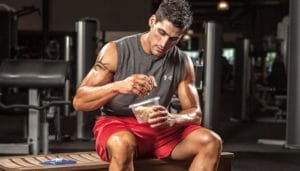 Does it exist? Most people are inclined to believe that there is no difference. The main thing is to start eating within 60-90 minutes after training. If this “window” exists, then we use it effectively – we close it. And if not, we eat protein foods and carbohydrates to stop catabolism and stimulate muscle growth. We win in both situations. But if you do not eat enough food during this period of time, then there is a risk that all efforts will be wasted.
Does it exist? Most people are inclined to believe that there is no difference. The main thing is to start eating within 60-90 minutes after training. If this “window” exists, then we use it effectively – we close it. And if not, we eat protein foods and carbohydrates to stop catabolism and stimulate muscle growth. We win in both situations. But if you do not eat enough food during this period of time, then there is a risk that all efforts will be wasted.
And now about the “protein-carbohydrate window”. Many do not believe in it and argue that there is no difference when to consume protein and carbohydrates. All that matters is the total amount of essential nutrients for the whole day. But there are many studies showing that athletes who ate protein-carbohydrate foods within half an hour after training achieved better results.
The total amount of protein consumed per day is extremely important for muscle growth. For example, if you weigh 90 kg and consume only 90 grams of protein per day, then, in principle, it does not matter that you consume it immediately after a training session. It is unlikely that you will be able to gain muscle mass. In terms of muscle growth physiology, taking both carbohydrates and protein for 60-90 minutes after the end of an intense exercise increases the chances of achieving better results.
Eating rules before yoga or Pilates
After a hearty breakfast, afternoon snack before Pilates, yoga should take four hours. A light snack allows you to shorten the break to 120 minutes.
How to properly organize sports nutrition
Initially, you need to understand that as such a universal menu does not exist – each organism is unique and has a number of its own characteristics. For example, someone does not want to eat at all in the morning, and is limited to coffee and toast, while others have a very strong appetite. It is very important to find a middle ground here. If we talk specifically about breakfast, then it is necessary to use it, since the body needs energy for the day ahead, moreover, the absence of this meal does not allow metabolic processes to work to the fullest.
When doing, for example, morning runs, remember about such a moment as a decrease in glycogen stores overnight. It is better to have a snack so that the concentration of sugar in the blood does not drop to the limit. Exercising regularly, you yourself will feel how much after sports you can eat – you need to listen to the body.
It is worth noting such an important point as drinking water. The body requires fluids, and you need to give it enough of it, otherwise dehydration is possible. Especially considering the fact that in the process of physical activity, the body already loses a lot of fluid. Experts recommend drinking 1-2 glasses of water before the start of classes so that the body can better rid itself of toxic substances. Also drink water during your workout to stay hydrated.
If you do not train in the morning, and you have them long enough – an hour or more, then you have time to eat a hearty meal in a couple of hours. And, as already mentioned, it is worth paying special attention to the right carbohydrates.
After class, you can have a snack after half an hour. Let the main meal be in about an hour, and the main foods that you should pay attention to are lean fish and meat, cereals, vegetables.
And, of course, do not forget that if you train hard, then your entire diet should be correct and balanced. It should have enough of the nutrients you need, proteins, carbohydrates, and healthy fats. It is in combination with proper nutrition that physical activity will give maximum results.
How to eat right after a set of strength exercises and cardio training
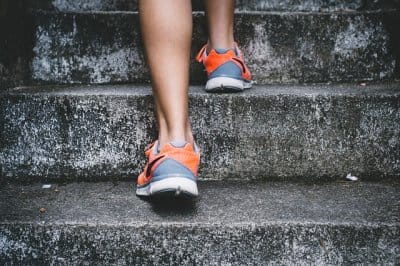 Cardio training is usually aimed at accelerating metabolic processes, starting the process of fat burning. To start losing weight, adjust the diet to reduce fat. To do this, choose foods with a low percentage of fat, leaving familiar and favorite foods during cardio training. These are cottage cheese, milk, sour cream, cheeses, dairy products.
Cardio training is usually aimed at accelerating metabolic processes, starting the process of fat burning. To start losing weight, adjust the diet to reduce fat. To do this, choose foods with a low percentage of fat, leaving familiar and favorite foods during cardio training. These are cottage cheese, milk, sour cream, cheeses, dairy products.
It is also important to reduce the intake of fat through proper heat treatment of food. We do not grill the chicken, but cook it, and simmer the vegetables in a little water. You can bake, stew, sauté, steam, choosing the most delicious way of cooking. As a dessert, sports trainers recommend after training to eat not baked goods with juice, but unsweetened tea with marmalade, marshmallow, marshmallow.
When it comes to strength training, it is important to increase the amount of protein. It should be present in the amount of 60-70% of the total food and consist of beef, veal, cottage cheese, fish, tofu cheese. Then the muscle mass will begin to gradually build up, turning into strong cubes and attractive biceps.
But after any workout, it is very important to eat your fill, because strength and cardio loads noticeably increase your appetite. In no case should you starve, practice mono-diets – a breakdown is inevitable, and after it a set of kilograms.
Useful Tips for Vegetarians
As a vegetarian, you can keep your body in good physical shape without eating meat products. Since protein is an essential part of a healthy diet and contributes to the growth of muscle mass, they can be replaced by:
- Legumes such as boiled beans, lentils, chickpeas
- Nuts and seeds are also high in vegetable protein;
- Eggs, as well as dairy products – milk, yogurt, kefir with a fat content of not more than 3.5% and cottage cheese with a fat percentage of not more than 9%.
The peculiarity of the vegetarian menu is that it is difficult to make it high in calories due to the lack of meat. However, sports nutrition in the form of protein shakes or gainers can come to the rescue.
Having set foot on the path of a healthy lifestyle and sports, one should not forget about nutrition. About 50% of success depends on it, and the remaining 50% is a correctly selected training program and exercise technique. Only a timely and correct meal, as well as a balanced menu, will allow you to achieve noticeable results within a few months.
It doesn’t matter what time you are used to exercising. The main rule of nutrition after a morning, afternoon or evening workout is to create a balanced menu that will replenish the supply of nutrients lost during sports.
However, when choosing what to eat, be guided by the general rules of a healthy diet: give up fat and fast carbs during the day, and try to saturate the body with protein and energy in the morning.
An approximate diet might look like this:
- a full portion of protein (meat, fish) – 200 g;
- fresh or stewed vegetables – 200 g;
- a portion of brown rice – 100 g;
- a teaspoon of any oil, such as walnuts.
The ideal post-workout meal is a warm salad of cucumber, tomato, Chinese cabbage and arugula. Add warm chicken breast fried in a dry skillet to greens and vegetables. We fill the salad with oil and eat, enjoying delicious healthy food. This dish can be eaten both in the morning and in the evening.
There is no difference between the diet of women and men. The only thing women can do is cut portions. But it is important to eat your fill. For drinks, choose herbal tea, clear water, or homemade lime lemonade with mint and a dessert spoon of honey.
Practical conclusions
What should be done after all?
Within 60-90 minutes after the end of physical activity, take solid protein-carbohydrate foods (eggs, poultry, meat or fish plus rice, buckwheat or potatoes). It is advisable to accompany all meals with the use of vegetables.
How much?
Depends on your weight:
- protein should be 20-40 grams;
- carbohydrates – (0.6-1) grams per 1 kilogram of weight.
On a scale of 1 to 10, post-workout nutrition is rated as 10, while the training load itself is around 7. Taking protein during this time increases muscle fiber synthesis more than throughout the rest of the day.
Low glycogen and insulin levels can completely stop muscle growth. This is why carbohydrate intake is critical post-workout.
In terms of gaining muscle mass and getting the most out of your hard work in the gym, a post-workout meal is the most important meal of the day.
Sources used and useful links on the topic: https://www.azbukadiet.ru/2018/09/20/cherez-kakoe-vremya-posle-trenirovki-mozhno-est.html https://ya-krasotka.com/1434685452959090820 / chto-mozhno-i-cherez-skolko-est-posle-trenirovki / https://www.fitnessera.ru/eda-i-sport-za-skolko-i-cherez-skolko-mozhno-zanimatsya.html https: //atletov.ru/food/chto-i-za-skolko-vremeni-est-pered-trenirovkoj/ https://proka4aem.ru/pitanie/pravilnoe-pitanie/mozhno-li-est-posle-trenirovki http: / /1trenirovka.com/pitanie/chto-mozhno-est-pered-trenirovkoj.html https://medru.su/pitanie/cherez-kakoe-vremya-posle-edy-mozhno-zanimatsya-sportom.html https: // gercules .fit / pitanie / sportivnoe-pitanie / eda-i-trenirovki / cherez-skolko-posle-edy-zanimatsya-sportom.html http://MasterGym.ru/fitnes-pomoshchnik/stati/zdorovoe-pitanie/chto-kushat-pered-trenirovkoj https://bodybuilding-and-fitness.ru/pitanie-sportsmenov/eda-pered-trenirovkoj.html https://nadietu.net/weight-gain/supplements/pered-trenirovkoy.html http://pitaniemoe.ru/eda-pered-trenirovkoj-v-trenazhernom-zale-rekomendatsii-i-primery/ https://mamadetochek.ru/cherez-skolko-posle-edyi-mozhno-zanimatsya-sportom/ https://nabor-massa.ru/pitanie-posle-trenirovki-chego-hotyat-ustavshie-myshtsy.html https://gercules.fit/pitanie/sportivnoe-pitanie/eda-i-trenirovki/cchto-i-cherez-skolko-est.html


